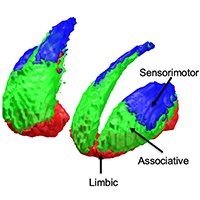Striatal topographical organization: Bridging the gap between molecules, connectivity and behavior

Accepted: 7 September 2021
HTML: 16
All claims expressed in this article are solely those of the authors and do not necessarily represent those of their affiliated organizations, or those of the publisher, the editors and the reviewers. Any product that may be evaluated in this article or claim that may be made by its manufacturer is not guaranteed or endorsed by the publisher.
Authors
The striatum represents the major hub of the basal ganglia, receiving projections from the entire cerebral cortex and it is assumed to play a key role in a wide array of complex behavioral tasks. Despite being extensively investigated during the last decades, the topographical organization of the striatum is not well understood yet. Ongoing efforts in neuroscience are focused on analyzing striatal anatomy at different spatial scales, to understand how structure relates to function and how derangements of this organization are involved in various neuropsychiatric diseases. While being subdivided at the macroscale level into dorsal and ventral divisions, at a mesoscale level the striatum represents an anatomical continuum sharing the same cellular makeup. At the same time, it is now increasingly ascertained that different striatal compartments show subtle histochemical differences, and their neurons exhibit peculiar patterns of gene expression, supporting functional diversity across the whole basal ganglia circuitry. Such diversity is further supported by afferent connections which are heterogenous both anatomically, as they originate from distributed cortical areas and subcortical structures, and biochemically, as they involve a variety of neurotransmitters. Specifically, the cortico-striatal projection system is topographically organized delineating a functional organization which is maintained throughout the basal ganglia, subserving motor, cognitive and affective behavioral functions. While such functional heterogeneity has been firstly conceptualized as a tripartite organization, with sharply defined limbic, associative and sensorimotor territories within the striatum, it has been proposed that such territories are more likely to fade into one another, delineating a gradient-like organization along medio-lateral and ventro-dorsal axes. However, the molecular and cellular underpinnings of such organization are less understood, and their relations to behavior remains an open question, especially in humans. In this review we aimed at summarizing the available knowledge on striatal organization, especially focusing on how it links structure to function and its alterations in neuropsychiatric diseases. We examined studies conducted on different species, covering a wide array of different methodologies: from tract-tracing and immunohistochemistry to neuroimaging and transcriptomic experiments, aimed at bridging the gap between macroscopic and molecular levels.
How to Cite

This work is licensed under a Creative Commons Attribution-NonCommercial 4.0 International License.
PAGEPress has chosen to apply the Creative Commons Attribution NonCommercial 4.0 International License (CC BY-NC 4.0) to all manuscripts to be published.
Similar Articles
- V. Pibiri, A. Ravarino, C. Gerosa, M.C. Pintus, V. Fanos, G. Faa, Stem/progenitor cells in the developing human cerebellum: an immunohistochemical study , European Journal of Histochemistry: Vol. 60 No. 3 (2016)
- Jun Liu, Linbin Cai, Yuanyuan He, Jun Yang, Apoptosis pattern and alterations of expression of apoptosis-related factors of supporting cells in Kölliker’s organ in vivo in early stage after birth in rats , European Journal of Histochemistry: Vol. 61 No. 3 (2017)
- F. Merigo, F. Boschi, C. Lasconi, D. Benati, A. Sbarbati, Molecules implicated in glucose homeostasis are differentially expressed in the trachea of lean and obese Zucker rats , European Journal of Histochemistry: Vol. 60 No. 1 (2016)
- E. De Nevi, P. Marco-Salazar, D. Fondevila, E. Blasco, L. Pérez, M. Pumarola, Immunohistochemical study of doublecortin and nucleostemin in canine brain , European Journal of Histochemistry: Vol. 57 No. 1 (2013)
- J.H. Song, M.Y. Lee, Y.J. Kim, S.R. Park, J. Kim, S.Y. Ryu, J.Y. Jung, Developmental immunolocalization of the Klotho protein in mouse kidney epithelial cells , European Journal of Histochemistry: Vol. 58 No. 1 (2014)
- Zhongli Shi, Wayne K. Greene, Philip K. Nicholls, Dailun Hu, Janina E.E. Tirnitz-Parker, Qionglan Yuan, Changfu Yin, Bin Ma, Immunofluorescent characterization of non-myelinating Schwann cells and their interactions with immune cells in mouse mesenteric lymph node , European Journal of Histochemistry: Vol. 61 No. 3 (2017)
- D.E. Korzhevskii, E.G. Sukhorukova, O.V. Kirik, I.P. Grigorev, Immunohistochemical demonstration of specific antigens in the human brain fixed in zinc-ethanol-formaldehyde , European Journal of Histochemistry: Vol. 59 No. 3 (2015)
- W.J. Liu, J. Yang, Preferentially regulated expression of connexin 43 in the developing spiral ganglion neurons and afferent terminals in post-natal rat cochlea , European Journal of Histochemistry: Vol. 59 No. 1 (2015)
- T. Karaca, Y. Hulya Uz, R. Karabacak, I. Karaboga, S. Demirtas, A. Cagatay Cicek, Effects of hyperthyroidism on expression of vascular endothelial growth factor (VEGF) and apoptosis in fetal adrenal glands , European Journal of Histochemistry: Vol. 59 No. 4 (2015)
- Yuka Maruyama-Koide, Sumiko Mikawa, Takeshi Sasaki, Kohji Sato, Bone morphogenetic protein-4 and bone morphogenetic protein receptors expressions in the adult rat eye , European Journal of Histochemistry: Vol. 61 No. 3 (2017)
<< < 1 2 3 4 5 6 7 8 9 10 > >>
You may also start an advanced similarity search for this article.

 https://doi.org/10.4081/ejh.2021.3284
https://doi.org/10.4081/ejh.2021.3284










